#early modern period
Text
So, just wanted to share that early modern pop-up astronomy books were a thing and they are absolutely glorious.


Here's a close-up of the little dragon-serpent guy, because he is especially magnificent.
#astronomy#early modern history#early modern period#dragon#astronomy book#pop up books#history of science#Leonhard Thurnheisser zum Thurn#astrolabium
3K notes
·
View notes
Text




Miniature wedding portraits of Frances and John Croker of Barton by Nicolas Hilliard, circa 1581.
#freckles#early modern#early modern era#early modern period#english renaissance#english#renaissance#cool#portraits#portrait#painting#paintings#wedding#romance#love#couple#marriage#romantic#pretty#handsome#aesthetic#academia#history#fashion history#fashion#style#interesting#nicolas hilliard#elizabethan#tudor
216 notes
·
View notes
Text

Frederick the Great Playing the Flute at Sanssouci by Adolph von Menzel, 1852.
#classic art#painting#adolph von menzel#german artist#19th century#realism#history#early modern period#frederick the great#people#musical instrument#concert#sanssouci#palatial interior
161 notes
·
View notes
Text


in small forgotten things // notes from a book i studied for my class on the history of printing
#studyblr#study blog#study aesthetic#early modern history#early modern period#early modernism#seventeenth century#light academia#light academic aesthetic#dark academia#romantic academia#academia#academia aesthetic#marginalia
145 notes
·
View notes
Note
Do we know when Western European elites stopped believing in magic and curses as a cultural rule?
I feel like the smallfolk lost an important point of leverage when nobles stopped thinking a witch could make his life a living hell if he was too much of an asshole.
I would peg it to the early Enlightenment in the 17th century.
However, I don't think it's correct to see magic and curses as a protection for the smallfolk - generally speaking, belief in witchcraft tends to justify violence and oppression against the most socially marginal, usually through the masses calling on local elites to use their authority to "protect" the community.
89 notes
·
View notes
Text



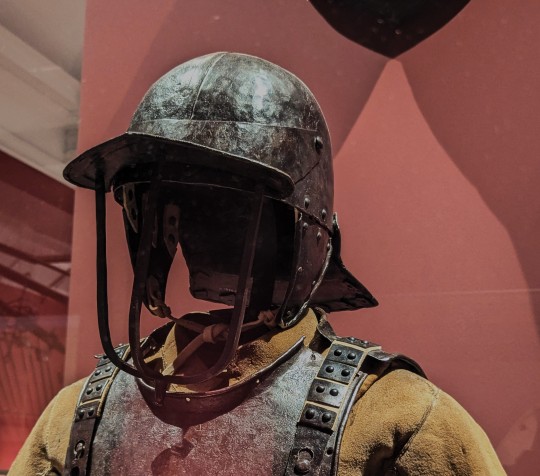
Harquebusier Armour from England dated to about 1680 on display at the Kelvingrove Art Gallery and Museum in Glasgow, Scotland
During the 17th century harquebusier cavalry were some of the most common in European armies. They were named after the carbine musket they used, the "harquebus" a shorter musket than the ones used by infantry. By 1680 though the Royal Scottish and English armies (later unified as the British Army) were converting these units in regiments of dragoons, mounted infantry who could also charge as cavalry. The armour was phased out of British cavalry regiments by the time of the 18th century.
Photographs taken by myself 2023
#armour#fashion#17th century#british empire#early modern period#england#english#military history#cavalry#kelvingrove art gallery and museum#glasgow#barbucomedie
111 notes
·
View notes
Text
People get the Witch Hunts all wrong

It is history-rant time. And today let me rant about one topic that just really gets me frothing at the mouth, because people will just mix up so many fucking things in this. And yeah, this is gonna be a long one. So strap in.
When it comes to the witch hunts, people are gonna have all sorts of ideas, that are just wrong. And today I wanna go and debunk some of them.
The myths for today:
The witch hunts were a medieval phenomenon.
The Spanish Inquisition was about witch hunts.
The witch hunts were about pegan religions.
Witches were all burned on the stake.
Witch hunts were all about women.
Actually, witch hunts established modern rights for defending yourself against accusations and were therefore good. (Yes. I heard that one.)

Myth 1: The Witch Hunts were a medieval thing.
I honestly do not know how often I have seen this one before. Like so many books and other media just keep harping on about this one. About the witch hunts happening in the middle ages. Which is just not true.
The middle ages are usually said to be 500 till 1500, though the most precide way to define them would be to say they lasted from 476 (the fall of the Roman Empire) till about the midth of the 15th century.
Meanwhile we also can argue exactly when the first witch was persecuted as such. Because there were people kinda persecuted for witchcraft, but actually executed for something else. But all in all the witch hunts started in the midth of the 15th century, aka, when the middle ages ended.
From there on there were witch hunts happening again and again all over Europe and later the US. It was not a constant thing that would happen every other week, but rather it would usually just hit an area like almost a collective mania. Then within a short time several people would be accused of witchcraft (often accusing each other) of which some would be executed. Then there would not be such a thing for several decades.
The reason, why witch hunts were not a thing of the middle ages, was that the church basically was not allowed to persecute crimes. And as the general society kinda saw magic as an in general more neutral thing, there were laws against black magic, but usually the punishment against those was not death.
And this changed in the 15th century, with the church getting more legal power.

Myth 2: The Spanish Inquisition was a witch hunt.
One thing that I do not quite get how it happened... A lot of people just claim that the Spanish Inquisition was a witch hunt... Which it was not.
There really is not much to say here. The Spanish Inquisition happened after the Reconquista war, aka after the Christians reclaimed the Iberian peninsula from the Muslims, who were ruling Iberia for a long while. And because the Christians at the time were a lot worse when it came to living peacefully with other religions than the Muslims of the time, they went out and wanted to force the Muslims (and the Jews who had fled to Iberia because of persecution in the Christian areas of Europe) to either convert to Christianity - or be killed.
Yes, that kinda turned into another craze that ended with a ton more people dead in the end, as after a while people were hunted down for all sorts of things... It really was mostly about hunting down Muslims and Jews.
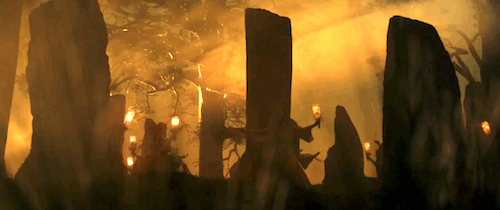
Myth 3: The witch hunts were all about pegan religions
With this myth I do know where it comes from. It comes from the neopagans, who usually have found their home with pegan religion within the last two generations, but love to claim that their family (especially their matrilinear line) totally always has been pegan, but they had to hide this because of the witch hunts. To be perfectly frank: This is mostly something that comes from white cis abled women, who desperately want to feel persecuted in some way.
But, yeah... I am not saying that there were no pegans killed during the witch hunts. Though of course the idea of keeping "pegans" as a different thing from Christians is kinda... complicated. Because for the most part in Europe it was not that Christianity totally extinguished the indigenous religions of whatever culture it took over, but rather supplemented it. This is super clear in Scotland and Ireland, but also in parts of Scandinavia.
A lot of those original religions have been lost, yeah. But... It was not quite how people imagine it to have gone when it comes to the conversion of people.
But in fact, the time this happened - the conversion of people towards Christianity and the pegan hunts that came with it - happened mostly between the 4th and the 8th century, so in the late Roman and early medieval period. And it was not what had happened in the witch trials.
The witch trials mostly went back to a very misogynist book of the "Malleus Maleficarum" - and to the church needing a good reason to get more power. It started out as: "Women are very corruptable. Satan has in fact corrupted so many women. Here is what you can do to find out whether a woman is a witch!" And from there it went to like: "Satan does want to corrupt us all! Everyone is corrupted by Satan!"
And a lot of it ended up being also directed against women, who held knowledge. Which was mostly connected to the entire push for more stricter patriarchal powers to come in. So, for example herbalists, who often taught their daughters, were often targeted, because they held knowledge and through that knowledge power. But also women in other positions of power.
And then... just everyone who was an inconvenience...
And disabled people...

Myth 4: All the witches were burned on the stake.
Another thing that keeps getting iterated in media a lot is the idea of witches burning on the stake. Because... I guess it is a pretty big image as an influence.
But... actually a lot of witches were simply hanged or beheaded. It kinda depended on the area and whoever was responsible for the witch hunts there. France in general was big on the burnings. But large parts of England were bigger on the hanging. Here in Germany some were burned and beheaded. And some were hanged first with their bodies then burned.
In some areas it shifted over time.
Nothing much more to say about this one. If you wanna write about some witch hunts, you should look up how people were killed in the version of witch hunts were you are from.
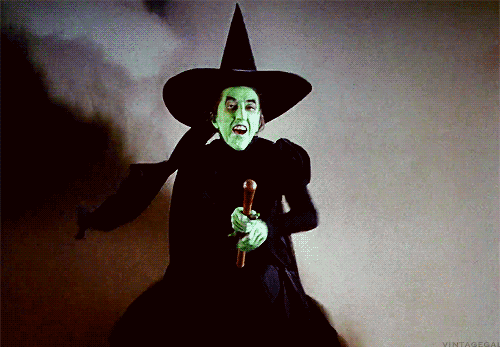
Myth 5: Witch Hunts only targeted women
As I said: Yes, the witch hunts definitely started with misogyny and was partly aimed at removing women from positions of influence and power. But they did not only target women. In fact in the end it was about equal with whom they targeted. In the end it was also highly dependend on the area. But... yeah. It is more complicated.
A just little fun fact: In Lichtenstein most of the "witches" killed were in fact men, because someone figured out that the entire "yeah, actually, we own the stuff the witch had owned" was way more profitable if you went for the men, who usually owned more things than women. Because patriarchy.
Another group that definitely was also targeted where people who were disabled or neurodiverse. Because they were often seens as being posessed by demons and such, due to people not understanding what was happening. This was especially true for people with turettes.
So, yeah. It started with misogyny and targeting women. But over the about 300 years during which most witch hunts happened, it shifted and spread from there.

Myth 6: The witch hunts gave us proper legal protocol
Okay, another one... This one I heard first from the father of my ex boyfriend, as he defended the bad things that had happened in the name of the church. But I have heard it several times since, so I think it is worth adressing.
The idea goes like this: "Well, actually during the witch hunts they introduced those neat legal concepts. Like, you could not be tortured more than three times, you were allowed to have a defendend and you could not be charged with the same crime twice! So it totally brought us modern legal practice!" Which... like...
*deep sigh* Honestly, that this has to be said. But... No.
First of all: Actually those things predate the witch hunts. And in fact torture was a thing that was not permitted as a form of interrogation in many areas where it became permitted during the witch hunts. Not saying it was not used as such still, just that it technically was not permitted. Just as the people just didn't give a flying fuck during the witch hunts on the legal limitations they had on the torture. People would often be tortured a) more than three times, b) for longer than allowed and c) with the kind of permanent injury that the law did not in fact allow. Because people did not care in the end. Same with the other things. And if you got a defendend, that defendend was not always on your side.
And, again, all those concepts predate the witch hunts. They were not universal, no. But they were not invented during the witch hunts.
So... Christ. If you really want to defend the senseless killing of people based on a made-up crime... Then at least think of some actual facts to defend it, rather than making shit up.
(Also I think this myth comes from history channel.)
So, yeah... That are some myths about the witch hunts that I have encountered several times. Are there some I missed?
#history#history rant#well actually#myths#historical myths#witch hunts#witch burning#medieval history#early modern history#early modern period#rant
75 notes
·
View notes
Text
Werewolf Fact #70 - Werewolves in medical history + "clinical lycanthropy"
The results of the werewolf fact poll over on my Patreon are in, and now we have this month's werewolf fact: all about werewolves in historical medical treatises of the Renaissance/Early Modern period and the term "clinical lycanthropy," as well as what all that means and how it still impacts werewolf studies and werewolf pop culture today.
This post will make use of a lot of primary sources, which I always find fun, so buckle up!

I've done several posts touching upon subjects similar to this before, you might be familiar with them, such as how werewolves in folklore are the result of a curse instead of a disease, and my two-parter on when werewolves became associated with insanity (Part 1 and Part 2 are here). You can also read a whole lot more about that topic and my arguments regarding it in my thesis, which was on werewolves, and can be found here on Amazon.com (hardback coming soon!).
However, I have never really delved in detail into a few of the actual medical treatises written during the Renaissance/Early Modern Period - in other words, primary sources - of which we have several. In this post, I will cover a few, but not all. I'm also going to make mention of a few more modern ones in regard to clinical lycanthropy, but let's start with older first...
First of all, there was a lot of discussion of "melancholy" in the 1500s in regard to werewolves. This was even referenced in the play The Duchess of Malfi (and I actually have an academic article dedicated to the discussion of the lines involving werewolves in said play). This is, of course, related to the ancient Greek theory of humors, in which the composition of the human body and health required the balance of four humors: black bile (earth), blood (air), choler (fire), and phlegm (water), each related to one of the classic elements.
Throughout the Renaissance, "wolf-madness" was attributed to a case of melancholy, or an excess of black bile. There are many examples of this. And, of course, there are also many attributions to Satan... which was not a thing at all before this time period, as before this, werewolves were even sometimes associated with Christianity (see: werewolves of Ossory, among others).
An oft-referenced source in both werewolf studies at large as well as my own works is "Admirable and Memorable Histories" by I. Goulart, from around 1607 and translated from French by Ed Grimeston; I use this source from my book A Lycanthropy Reader by Charlotte F. Otten. Please note that the language of the piece is dated, so it will read funny to modern audiences.
Goulart discusses "Licanthropes and mad-men, the which wee will consider of two sorts," not necessarily equating those suffering from "lycanthropy" as mad-men, but as those "in whom the melancholike humor doth so rule, as they imagine themselves to be transformed into Wolves." He refers to them as "counterfet Wolves" and discusses how they "runne into Church-yardes, and about graves," something not uncommonly seen in the newfangled werewolf sources of the 1600s onward but not commonplace in werewolf legends of previous time periods.
Goulart also discusses men "tormented with an evill spirit, that at a certaine season of the yeare, hee imagined himselfe to bee a ravening Wolfe," and references other elements seen only in the later werewolf trials as opposed to previous werewolf legends. I also can't help but wonder if the "certain season" element is something Curt Siodmak saw and carried over into the original werewolf in The Wolf Man turning during a particular season (when wolfsbane blooms in autumn)...
Anyway, another of Goulart's sources is Job Fincel in 1541, who describes werewolves in ways we see around a lot when googling and finding garbage on the internet but not so much in legends previously, such as how those afflicted with the "disease" of believing themselves to become a wolf (but not actually turning into one) "are pale, their eyes are hollow, and they see ill, their tongue is drye, they are much altered, and are without much spittle in the mouth." This is consistent with particular illnesses rather than anything seen in werewolf legends, as these are not the people who truly become wolves, only those who believe that they do - and Goulart was still drawing lines between those with hallucinations, those who actually change shape, and those who are werewolves by other means. For example, Goulart also discusses the idea of people whose souls fly from their own bodies and enter into the forms of wolves instead.
There are other examples that discuss these same topics, of course, including but not at all limited to "Diseases of the Mind" by Robert Burton and "A Treatise" by Robert Bayfield, both of which are also featured in A Lycanthropy Reader, and there are plenty of others in assorted other werewolf studies publications.
Now, in addition to these older examples, we also have much more recent medical studies regarding what is known in modernity as "clinical lycanthropy."
Here's a fun fact: the term "lycanthropy" wasn't ever used in antiquity to refer to werewolf legends. It was created by the medical profession in the 1500s to refer specifically to a form of madness, not shapeshifting. It referred to what was recognized as a mental illness that they called lycanthropy: someone believing that they turned into a wolf, not to someone actually turning into a wolf (as in, not referring to the legends in which this happened).
Today, we call this "clinical lycanthropy," because the term "lycanthropy" was basically taken by werewolf media and werewolf studies and retroactively applied to werewolf legends. But the term "lycanthropy" was never actually used in said legends.
The term "lycanthropy" to refer to a "werewolf disease" is just another way in which medical studies and Renaissance writings turned werewolf legends into a "werewolf disease" instead of a magical curse, as it always used to be.
Now, of course, the medical world doesn't really recognize "clinical lycanthropy" anymore. It's considered to be a part of other mental conditions, the result of drug-induced hallucinations, or something entirely different. Several cases were attributed to schizophrenia instead, for example. So the term "clinical lycanthropy" in itself is all but outdated.
I won't be including or directly quoting from the case reports from the 1970s in this discussion, as this post is already enormous and, frankly, the case reports are not things that could be easily discussed in today's environment, as the language in the reports would certainly be considered offensive today, and that's not something I want to navigate. So I won't get into all that. They're out there if you want to read them, but I won't bother breaking them down here.
There are also certainly other examples of medical history relating to werewolves and werewolf legends, but I'll save all that for the werewolf facts book or another publication of mine!
Medical treatises are just another example from the Renaissance (and for quite a while after, into at least the 1800s and even early 1900s) of trying to rationalize and find "scientific explanations" for all manner of folklore and mythology. This also resulted in a considerable amount of condemnation for those who still believed in this sort of thing, as well as those who believed themselves to be experiencing it. As mentioned in some of my other werewolf facts, this didn't always include punishment (many victims of clinical lycanthropy at the time were actually well taken care of), but it did include things like being locked away from society for being declared insane. And, of course, if the victim in question was not a victim but a perpetrator, then it would result in a trial and punishment - and often execution. However, this was much more likely to happen to witches rather than werewolves. Just another way in which the trial of Peter Stubbe were very obviously witch/sorcerer trials and had nothing to do with werewolves at all.
Now, of course, you'll also recognize that a lot of the things you see in the treatises I used as examples don't follow up with many or even any werewolf legends you're very familiar with. Things were getting a bit weird at this point in history in regard to folklore and the like, and the reaching for rationalizing something like a person turning into a wolf or wolf-monster of any sort certainly resulted in some wild connections.
While this is far from the werewolf legends that personally fascinate me most, they are an important part of werewolf studies - hugely so. In fact, they're often discussed more than almost anything else, because unfortunately werewolf scholars are overly obsessed with later time periods that I personally find less fun and interesting than the Middle Ages and ancient times. But, hey, I love all of it.
Until next time!
And remember, if you want to vote on the next werewolf or vampire or other folklore fact, be sure to check out my Patreon. Thanks for reading!
( If you like my werewolf blog, be sure to follow me here and check out my other stuff!
Patreon — Personal Website (new and improved! Great starting point!) — Wulfgard — Werewolf Fact Masterlist — Twitter — Vampire Fact Masterlist )
#werewolf#werewolves#werewolf fact#werewolf facts#werewolf wednesday#werewolfwednesday#folklore#folklore facts#mythology#wolf#wolves#madness#medical treatises#renaissance#early modern period#lycanthrope#lycanthropes#lycanthropy#clinical lycanthropy
57 notes
·
View notes
Text
Werewolf of Ansbach, c. 1685.
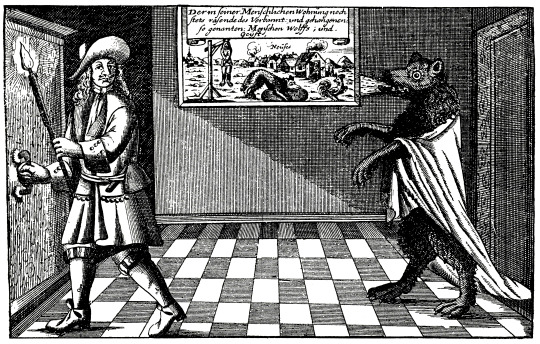
220 notes
·
View notes
Text

I love you like an atom bomb, but I've become a cold reactor!!!
Lyrics by Everything Everything - “Cold Reactor” Illustration by Jules-Ferdinand Jaquemart, “François Ier’s Sword” (1864)
#mm#my edit#digital edit#lyric edit#knightcore#oddcore#weirdcore#early modern period#illustration#mixed media#typography#everything everything#some lyric stuff bc I’m too lazy to write#eyestrain
13 notes
·
View notes
Text

phases of the moon by Galileo Galilei
1609 or 1610
11 notes
·
View notes
Text
Obsessed by the sheer number of sea monsters on this map of Africa that I came across! This is only 1/4 of it, and look at how many the cartographer put in!!! Convinced this expanse of ocean beyond Madagascar was included just so he could put in the sea monsters.
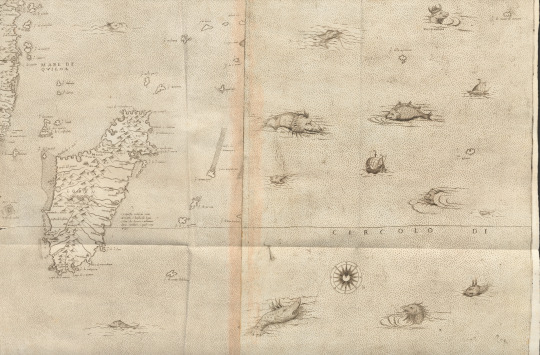
And lots of close-ups, because you need to see them!!!





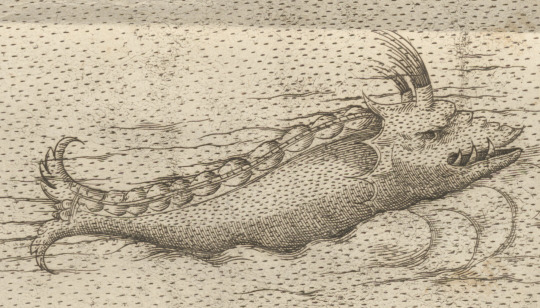


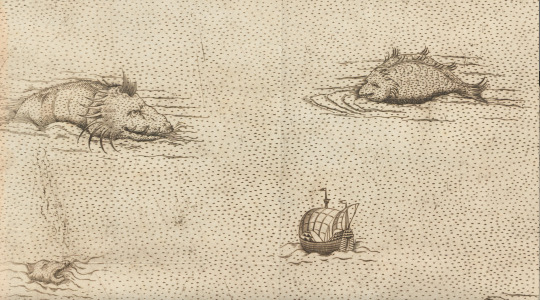

And a link to the source (Il disegno della geografia moderna de tutta la parte dell'Africa, Giacomo Gastaldi, 1564) so you can all have fun seeing them up close and personal too: https://www.digitale-sammlungen.de/en/view/bsb00092152?page=,1
#early modern italy#early modern period#early modern history#sea monster#cartography#early modern cartography#africa#the range of these sea monsters oh my goodness i am losing my mind#giacomo gastaldi#Il disegno della geografia moderna de tutta la parte dell'Africa#maps#old maps#historical maps
64 notes
·
View notes
Text

Portrait miniature of an unknown young man (c. 1588) by Nicolas Hilliard from the Victoria & Albert Museum
#the 80s just called#the lost boys stole his style#INXS#early modern era#early modern period#early modern#shakespearean#16th century#nicolas hilliard#art#portrait#portraiture#portrait miniature#fashion#style#elizabethan#tudor era#history#beauty#aesthetic#cool
15 notes
·
View notes
Text
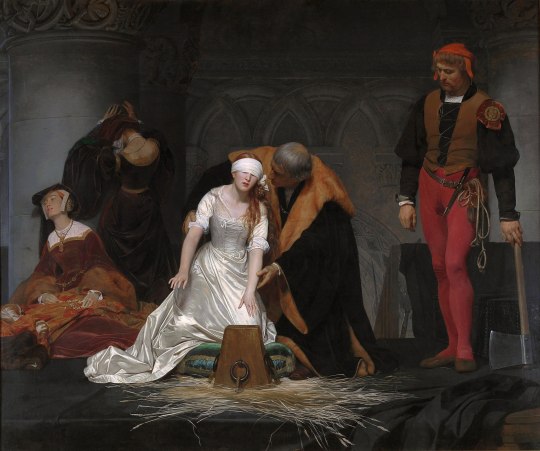
The Execution of Lady Jane Grey by Paul Delaroche, 1833.
#classic art#painting#paul delaroche#french artist#19th century#romanticism#history#early modern period#jane grey#woman#people#white dress#death#inside
35 notes
·
View notes
Text
Please promulgate so we may see everyone’s opinion on the Tudor Era Thomases (Henry VIII edition)
Also, take a shot for each Thomas on the list who was executed!
#the tudors#cromwell#Cranmer#Thomas more#Thomas Cromwell#Tudor era#history#Thomas Wolsey#cardinal Wolsey#henry viii#Tudor England#early modern period#early modern England#16th century
80 notes
·
View notes
Note
Why do economists need to shut up about mercantilism, as you alluded to in your post about Louis XIV's chief ministers?
In part due to their supposed intellectual descent from Adam Smith and the other classical economists, contemporary economists are pretty uniformly hostile to mercantilism, seeing it as a wrong-headed political economy that held back human progress until it was replaced by that best of all ideas: capitalism.

As a student of economic history and the history of political economy, I find that economists generally have a pretty poor understanding of what mercantilists actually believed and what economic policies they actually supported. In reality, a lot of the things that economists see as key advances in the creation of capitalism - the invention of the joint-stock company, the creation of financial markets, etc. - were all accomplishments of mercantiism.
Rather than the crude stereotype of mercantilists as a bunch of monetary weirdos who thought the secret to prosperity was the hoarding of precious metals, mercantilists were actually lazer-focused on economic development. The whole business about trying to achieve a positive balance of trade and financial liquidity and restraining wages was all a means to an end of economic development. Trade surpluses could be invested in manufacturing and shipping, gold reserves played an important role in deepening capital pools and thus increasing levels of investment at lower interest rates that could support larger-scale and more capital intensive enterprises, and so forth.
Indeed, the arch-sin of mercantilism in the eyes of classical and contemporary economists, their interference in free trade through tariffs, monopolies, and other interventions, was all directed at the overriding economic goal of climbing the value-added ladder.
Thus, England (and later Britain) put a tariff on foreign textiles and an export tax on raw wool and forbade the emigration of skilled workers (while supporting the immigration of skilled workers to England) and other mercantilist policies to move up from being exporters of raw wool (which meant that most of the profits from the higher value-added part of the industry went to Burgundy) to being exporters of cheap wool cloth to being exporters of more advanced textiles. Hell, even Adam Smith saw the logic of the Navigation Acts!

And this is what brings me to the most devastating critique of the standard economist narrative about mercantilism: the majority of the countries that successfully industrialized did so using mercantilist principles rather than laissez-faire principles:
When England became the first industrial economy, it did so under strict protectionist policies and only converted to free trade once it had gained enough of a technological and economic advantage over its competitors that it didn't need protectionism any more.
When the United States industrialized in the 19th century and transformed itself into the largest economy in the world, it did so from behind high tariff walls.
When Germany made itself the leading industrial power on the Continent, it did so by rejecting English free trade economics and having the state invest heavily in coal, steel, and railroads. Free trade was only for within the Zollverein, not with the outside world.
And as Dani Rodrik, Ha-Joon Chang, and others have pointed out, you see the same thing with Japan, South Korea, China...everywhere you look, you see protectionism as the means of achieving economic development, and then free trade only working for already-developed economies.
#political economy#mercantilism#economic development#early modern state-building#early modern period#laissez-faire#classical liberalism#classical economics#economics#economic history
57 notes
·
View notes